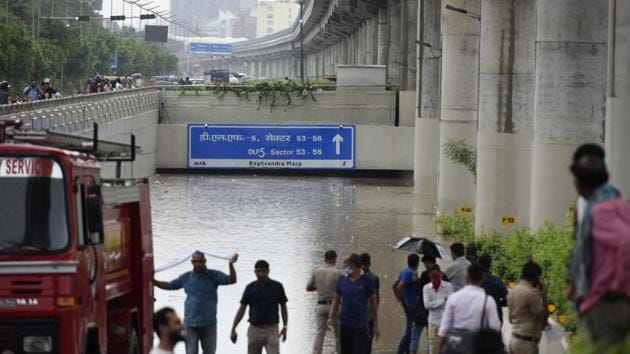Five reasons why Gurugram gets flooded every time it rains
The city’s limited drainage capacity, disruption of the hydrological flow of natural drains, and delayed monsoon preparedness were the main reasons for Gurugram sinking after Wednesday’s rains, experts say
The Millennium City kept its annual date with monsoon on Wednesday resembling an ocean after heavy rains and waterlogging inundated the city and left people stranded. The city’s limited drainage capacity, which results in Badshahpur drain overflowing during heavy rains, disruption of the hydrological flow of natural drains, which has stopped the flow of water into traditional dams, and delayed monsoon preparedness were the main reasons for Gurugram sinking after Wednesday’s rains, experts said. We take a look at five things why Gurugram gets flooded every time it rains.

Delay in monsoon preparedness
Municipal Corporation of Gurugram (MCG) and Gurugram Metropolitan Development (GMDA) officials have attributed the delay behind monsoon preparedness to the raging Covid-19 outbreak. The draining cleaning operations started only in June because of the pandemic.
GMDA looks after all master drains in the city, while the MCG takes care of the arterial ones.
A master drain carries the sewage of more than one sector or a neighbourhood, while an arterial drain is a network of pipelines in a residential colony or a sector.
Earlier on March 21, MCG officials were instructed to take care of basic civic amenities and put a stop all other work owing to the Covid-19 outbreak.
Later, though the civic authorities turned their attention to the cleaning of drains in mid-April, however, work didn’t get underway until June. It was a case of too little, too late.
Too little time left, too much to do
Usually, any cleaning operation for a drain takes about two months, including desilting, ahead of the monsoon season.
Typically, MCG and GMDA authorities float tenders for cleaning the drains in March and April, and by May, the work is at an advanced stage.
But the civic bodies’ plans came unstuck this year because of the unprecedented Covid-19 outbreak. MCG authorities floated the first set of tenders in May. While GMDA authorities followed suit and got into the act in early June.
GMDA had to do the heavy-lifting for crucial stretches such as IFFCO Chowk-Rajiv Chowk, areas along the Delhi-Gurgugram Expressway, Subhash Chowk-Vatika Chowk on Sohna Road, Bakhtawar Chowk-Subhash Chowk in Sector 34, and near Hero Honda Chowk.
The civic body was found wanting in the end.
Acute manpower crunch
It takes at least three weeks to award a contract. However, amid the Covid-19-triggered hard times, the contractors faced an acute shortage of manpower, as most of the migrant workers had left for their native places in Bihar, Jharkhand, and Uttar Pradesh following the nationwide lockdown restrictions that were enforced from March 25 to contain the spread of the contagion.
Contractors’ manpower strength was reduced to 30%. Consequently, the work progressed at a snail’s pace amid a looming monsoon.
No outlet for rainwater
The drainage system in Gurugram leaves a lot to be desired, as was evident from the flooding of seven underpasses on Wednesday.
Every year, the Haryana Urban Development Authority’s (HUDA) master drainage lines either get choked at critical points or are bursting at their seams during monsoon. There is no outlet for the accumulating rainwater to be released. Raman Sharma, chief engineer, MCG, said most of the rainwater flowed back into Gurugram due to lack of outlet, flooding the satellite town’s thoroughfares and residential areas.
Blocked natural drains
Gurugram of the 1980s was a pristine landscape, dotted with “jheels”, or water bodies in the low-lying parts of what has since morphed into a millennium city with its distinctive skyline of glitzy skyscrapers and glass-fronted offices and trendy shopping malls. The water bodies in the Aravallis were ideal to drain the rainwater. Rapid urbanisation through the 1990s and the turn of the new millennium led to blockage of natural drains.
A land revenue record from 1956 showed Gurugram had around 640 water bodies, which has since whittled down to 251 in 2018-19.
And, there hangs the tale of the annual flooding woes of the Millennium City.



